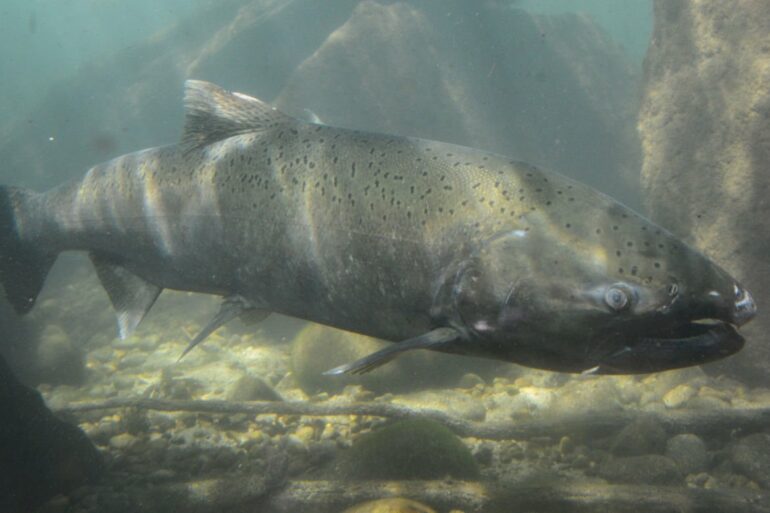Salmon famously travel hundreds of miles upstream to reach their home waters to spawn, but climate change is shrinking their destination. A new study offers high-resolution details on how Chinook salmon habitats are being lost on Bear Valley Creek, a headwater stream of the Salmon River in central Idaho.
The study, published today in the AGU journal Geophysical Research Letters, suggests lower water volumes and warming temperatures are dramatically shrinking spawning beds and nurseries for the culturally and economically important fish. Researchers predict salmon here could lose nearly half their total habitat in this river as soon as 2040 due to an estimated 50% decrease in river discharge.
Daniele Tonina, lead author of the new study and a professor of ecohydraulics at the University of Idaho, and colleagues examined a 14-kilometer stretch of Bear Valley Creek, which is known for hosting a robust population of Chinook salmon. With a wide valley, meandering main river and cozy side-streams, the site is representative of ideal salmon habitats in the Pacific Northwest.
The team mapped the river’s channels and floodplain using a kind of remote, 3D laser scanning, or LiDAR, that uses green-wavelength lasers to see into shallow aquatic environments. They then used 60 years of historical stream-flow data, from 1957 to 2016, from stream gauges at eight nearby streams to calculate trends in the annual summer discharge, a critical time for fish survival. Using three different hydrologic models to combine the river features and predicted discharge until 2090, they estimated changes to salmon habitat both in the past and over the coming decades.
Over the historical study period, summer stream flow volume dropped by 19%, and it slowed by 17%. That means less overall area suitable for salmon nests and a loss of off-channel havens for fingerlings as side-streams get cut off from the main channel. About 20% of this critical off-channel habitat was already lost over the 60-year period, the study estimated. The salmon lost 23% of their spawning habitat as well.
“This really allowed us to understand how the environment will change at different discharges, which hasn’t really been done before. Now we can say the impact will be that the habitat gets smaller and more fragmented, meaning even the parts that are still good [quality] might be too small to be useful,” Tonina said. “Still, this is a glass half-full, half-empty result. At least it’s not a total loss of habitat yet.”
“A huge limitation has been our ability to study the landscape at a scale that’s biologically relevant for salmon,” said Lisa Crozier, a research ecologist at NOAA’s Northwest Fisheries Science Center who was not involved in the study. “We know the overall pattern is that low flows are bad for fish, but we don’t know exactly why or what life stages are most impacted. But here, we can see very specifically they’re losing off-channel and spawning habitat. It really helps to know those details.”
Saving salmon streams
Salmon have exacting requirements for their nests. Each female can use up to six square meters of riverbed real estate to lay her eggs; the gravel must be just right, the water must be cold and rushing, there must be calm side streams for fingerlings to grow. And of course, there must be enough water flowing in the streams to let the salmon arrive in the first place. Each requirement is threatened.
Smaller salmon habitats of poorer quality could reduce the success of spawning and increase struggles for young salmon, which already face a host of human-caused barriers. More female salmon may be competing for shrinking nest sites, and young salmon will compete for dwindling space and resources as well. Breeding salmon whose home waters are cut off or disappear altogether may expend too much energy searching for a new spot and die of exhaustion before laying their eggs.
Studies like this one help ecologists and conservationists figure out what areas are most likely to remain suitable habitats for salmon and other species, and can therefore be targeted for protection, Tonina said. Other cold-water fish, such as trout and steelheads, would be impacted in similar ways. Chinook salmon serve as a useful “indicators of enormous ecosystem change,” Crozier added, but “every single species will be affected by these changes. It’s uncharted territory.”
“This will inform restoration efforts, helping us select streams that are likely to remain accessible for the salmon,” Tonina said. “We want to find the areas that will serve as refugia in the future.”
More information:
Daniele Tonina et al, Climate Change Shrinks and Fragments Salmon Habitats in a Snow‐Dependent Region, Geophysical Research Letters (2022). DOI: 10.1029/2022GL098552
Provided by
American Geophysical Union
Citation:
Climate change is shrinking and fragmenting salmon habitat (2022, June 28)



